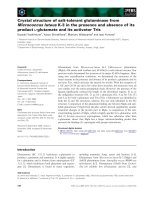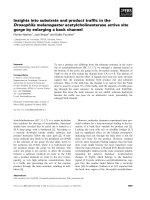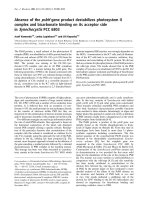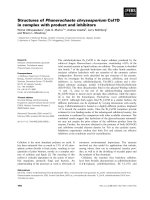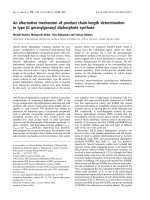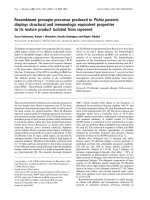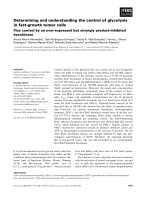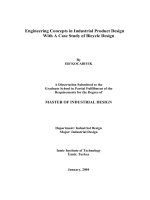STATE-OF-THE-ART IN PRODUCT SERVICE-SYSTEMS
Bạn đang xem bản rút gọn của tài liệu. Xem và tải ngay bản đầy đủ của tài liệu tại đây (215.37 KB, 25 trang )
<span class="text_page_counter">Trang 1</span><div class="page_container" data-page="1">
<b>State-of-the-art in Product Service-Systems </b>
Baines, T; Lightfoot, H; Evans, S; Neely, A; Greenough, R; Peppard, J; Roy, R; Shehab, E; Braganza, A; Tiwari, A; Alcock, J; Angus, J; Bastl, M; Cousens, A; Irving, P; Johnson, M; Kingston, J; Lockett, H; Martinez, V; Micheli, P; Tranfield,
D; Walton, I; and Wilson, H
<i><b>Correspondence to: </b></i>
Tim Baines
Professor of Strategic Manufacture
Department of Manufacturing, Building 50 Cranfield University
Bedfordshire MK 43 OAL
</div><span class="text_page_counter">Trang 2</span><div class="page_container" data-page="2"><b>State-of-the-art in Product Service-Systems </b>
<b>Abstract </b>
A Product Service-System (PSS) is an integrated combination of products and services. This western concept embraces a service led competitive strategy, environmental sustainability, and the basis to differentiate from competitors who simply offer lower priced products. This paper aims to report the state-of-the-art of PSS research by presenting a clinical review of literature currently available on this topic. The literature is classified and the major outcomes of each study are addressed and analysed. On this basis, this paper defines the PSS concept, reports on its origin and features, gives examples of applications along with potential benefits and barriers to adoption, summarises available tools and methodologies, and identifies future research challenges.
<b>1. Introduction</b>
The concept of a Product Service-System (PSS) is a special case of servitization. A PSS can be thought of as a market proposition that extends the traditional functionality of a product by incorporating additional services. Here the emphasis is on the ‘sale of use’ rather than the ‘sale of product’. The customer pays for using an asset, rather than its purchase, and so benefits from a restructuring of the risks, responsibilities and costs traditionally associated with ownership. Similarly, the supplier/manufacturer can improve their competitiveness as these ‘solutions’ may be clearly differentiated from product based offerings while, simultaneously, retaining asset ownership which can enhance utilisation, reliability, design and protection.
For some authors the concept of a PSS also embraces sustainability. The underpinning expectation is that a pure PSS will have a lower environmental impact than, simply, a more traditional transaction where an enterprise manufactures products but then transfers responsibilities of ownership and use to the customer. An illustration of both the business and environmental benefits of a PSS is apparent in the Total-Care Package offered to airlines by Rolls-Royce Plc. Here, rather than transferring ownership of the gas turbine engine to the airline, Rolls-Royce (R-R) lease out “power-by-the-hour”. The gas turbine technology is world leading and the spares and maintenance service they offer exemplary. Furthermore, as R-R maintains direct access to the asset they can collect data on product
</div><span class="text_page_counter">Trang 3</span><div class="page_container" data-page="3">performance and use. Such data can then enable the improvement of performance parameters (for example maintenance schedules, etc) to improve engine efficiency, improve asset utilisation, and so reduce total costs and the environmental impact.
PSS is a potentially valuable concept for manufacturers based in developed economies. Manufacturing industries world-wide continue to undergo colossal change. Many traditional producers are increasingly challenged by countries with a low cost labour base, with the survival of many European operations continuously in doubt, and the relocation of production facilities prolific. There is however still a strong desire that the UK should retain a viable manufacturing capability. Manufacturing directly underpins exports, strengthens the service based economy, and complements the science and engineering research base. Thus the popular advice to manufacturers is that, to sustain competitiveness, they should ‘move up the value chain’ and focus on delivering knowledge intensive products and services [1]. Such actions are entirely consistent with the adoption of a PSS based competitive strategy which uses deep product, process and customer knowledge to reduce total cost of a product.
The concept of PSS has been openly discussed in the literature for over a decade (see for example Goedkoop et al [2], Mont [3], Meijkamp [4], Manzini & Vezzoli [5]), yet the uptake of such ideas by industry appears limited. Although many benefits are apparent from the literature and existing cases, some major inhibitors are reported to arise across the design and management of engineering, manufacturing and supply chain operations. However, a concerted and coordinated research programme could address many of these and provide a platform of knowledge and technologies that enable the wide scale adoption by manufacturers of competitive strategies centred on PSS. Such research itself requires a thorough and precise understanding of existing work and, so, the purpose of this paper is to describe the state-of-the art with PSS.
The study described in this paper has taken the form of a rigorous literature review. The methodology consisted of identifying relevant publication databases, searching these using a wide range of key words and phrases associated with PSS, and fully reviewing each article identified. From these reviews it was possible to compile a set of key findings. These findings and their implications for research are all described in the paper. Hence, this paper is structured as follows. First, the research methods are described and the initial results of the search for relevant literature are summarised. Key
</div><span class="text_page_counter">Trang 4</span><div class="page_container" data-page="4">findings are then presented through analysis of the literature. Finally, the results of this analysis are summarised and discussed, and conclusions are drawn.
<b>2. Research Programme</b>
<b>2.1 Aim, scope and research questions</b>
The aim of the research presented in this paper has been to identify, interpret and summarise the literature currently available on PSS. In scoping this study, the focus has been on articles that are central and relevant to PSS within a wider manufacturing context. An example of a publication that is clearly within the scope of this review is that of Mont [6] in which the author clarifies the concept of Product Service-Systems. Similarly, articles that deal with services associated with engineering, supply, production and after-sales support have all been considered relevant. This strict distinction has been necessary to deal precisely with the concept of PSS. We are however mindful of the many articles more widely associated with service provision that, although they fall outside the focus of this initial review, may be translated into a useful contribution to the PSS research activity. These will subsequently receive our attention in a future paper.
In terms of research questions, we approached this study by posing the following questions:
•
<i>What is a PSS and how is it commonly defined?</i>•
<i>How does an enterprise that deliberately configures itself around PSS differ from a conventional design & make enterprise, and what are the consequences?</i>•
<i>Where are the leading examples of PSS practice?</i>•
<i>Where are the strengths and weaknesses in the existing literature?</i>The purpose of these questions was to guide the search, with the authors being mindful that existing literature may be insufficient to allow these to lead directly to key findings.
<b>2.2 Search strategy</b>
The search strategy was developed by first identifying the relevant data sources, time frame and key words. Initially a very broad selection of databases were identified, to cover a diverse range of publication formats including journal articles, conference proceedings, theses, books, and articles from trade journals. These databases included Compendex, Inspec and Emerald, along with the more traditional library cataloguing systems providing access to a variety of publications from the Harvard
</div><span class="text_page_counter">Trang 5</span><div class="page_container" data-page="5">Business Review through to the Journal of Cleaner Production, Journal of Design Research, and Proceedings of Eco-design. In addition, they provide access to international reports, such as those by the United Nations Environmental Programme and the Dutch and Swedish government departments. The search strategy initially identified key words that could be associated with PSS. Examples of these include: servitization, sustainability, service economy, remanufacturing, service design, productization, product substituting service, dematerialisation, system solution, and functional economy. Initially this study focused on literature published between 1995 and 2006, with their citations being cross-checked to ensure any earlier publications were also captured. The principal research databases were then searched using a range of combinations of these key words. The lists of hits for each search string were firstly edited to remove any duplicate records that appeared, the titles were checked to ensure relevance to the review, and then the abstracts of all other articles and papers were reviewed before selecting publications for a full review.
For completeness an internet search was also conducted using a similar process to that used with the library databases. The results of these searches combined to provide the following results.
<b>2.3 Results and analysis</b>
Initially the search terms identified some 80 articles, reports and theses. These were then carefully filtered to establish 33 documents that were directly relevant to our research enquiry. Subsequent cross checking of references increased the list to 40, and it is the analysis of these articles (References 1 to 29 and bibliography 1 to 11) that forms the basis of the findings in this paper.
The analysis itself was aided by applying mind mapping techniques to capture and cluster the main themes and contributions. These were then presented at an industrial seminar which helped the researchers to test the clarity and completeness of their findings. These are now discussed in detail.
<b>3. Generation of key findings</b>
The literature review process generated the following nine key findings.
<b>3.1 Definition of a Product Service-System</b>
Clear definitions are an essential starting point for all research and this has been the case with this literature review. The first formal definition of a PSS was given in 1999 by Goedkoop et al [2] Since
</div><span class="text_page_counter">Trang 6</span><div class="page_container" data-page="6">then most contributors have broadly adopted this definition (see Table 1), and generally interpret a PSS as a ‘product(s) and service(s) combined in a system to deliver required user functionality in a way that reduces the impact on the environment’. Goedkoop et al [2] add further clarity by also defining the key elements of a PSS, namely:
• Product: a tangible commodity manufactured to be sold. It is capable of ‘falling on your toes’ and of fulfilling a users needs.
• Service: an activity (work) done for others with an economic value and often done on a commercial basis.
• System: a collection of elements including their relations.
Most authors see the purpose of a PSS as a competitive proposition, and so directly refer to the need for customer satisfaction and economic viability. In addition, many link PSS with achieving sustainability, but only Manzini et al [7] see this as the ultimate goal. Intriguingly, the concept of dematerialisation is frequently discussed in the literature by authors (e.g.: Mont [8], Ehrenfeld [9], Manzini & Vezzoli [5], Wong [10], Tomiyama [11]), when describing the concept of PSS. Dematerialisation refers to the opportunity that a PSS offers to break the link between value delivered to the customer/user and the amount of physical material needed to create that value. While this is often stated as an important aim for many PSS practitioners and researchers, the term does not
<i>appear in any of the definitions. This exploration of a definition of a PSS leads us to summarise: Finding 1: “A Product Service-System is an integrated product and service offering that delivers </i>
value in use. A PSS offers the opportunity to de-couple economic success from material consumption and hence reduce the environmental impact of economic activity. The PSS logic is premised on utilising the knowledge of the designer-manufacturer to both increase value as an output and decrease material and other
<i>costs as an input to a system. </i>
<b>3.2 Evolution of the Product Service-Systems concept </b>
The first publication on PSS was by Mark Goedkoop et al in 1999 [2]. Titled ‘Product Service-Systems – Ecological and Economic Basics’, this was commissioned by the Dutch Ministries of Environment and Economic Affairs, and has subsequently been cited by the majority of authors publishing in this field. However, the most prolific author has been OksanaMont [3, 6, 8 & 12], with both Meijkamp [4],
</div><span class="text_page_counter">Trang 7</span><div class="page_container" data-page="7">Manzini & Vezzoli [5] and Manzini et al [7] also making large contributions. Since the first paper by Goedkoop et al [2] the number of articles on PSS grew steadily, peaking in 2003/4 when 11 papers were published. Since then there has been a decline in contributions, with the most recent being within a special edition of the Journal of Cleaner Production (volume 14) in 2006.
The Journal of Cleaner Production has also been the most popular dissemination route for articles on PSS. Here, papers have covered a range of topics associated with the principles, strategies and developments in PSS. This journal, along with similar technical journals (e.g. the Journal of Design Research and the EcoDesign Journal) has been the platform for almost 80% of publications. A further 15% of articles have appeared as special reports. Collectively these articles have covered a range of topics, with approximately 20% describing business benefits and drivers (e.g. 2, 6 & 7), 20% reviewing the characteristics of PSS (e.g. [6, 3 & 14]), and about 35% focusing on case studies and examples (e.g. [2, 3, 5, 13, 15, 16 &17]). Other topics are related to product life-cycle ([18 & 19]), service design methods [20], and service engineering [11].
In terms of origin, most authors since 1999 have been Scandinavian (particularly from Sweden), the Netherlands or Italy. A few articles on PSS have emerged from Asia (e.g. 11 & 20). Surprisingly, there have been no authors from North America directly publishing on the topic of PSS, although several authors do refer to successful applications in this region (e.g. 21 & 22). In recent years more articles have originated in the UK (e.g. 10, 23, 24 and 25). Finally, most authors are from the disciplines of Environment, Sustainability, Economics and Ecology, with very few contributions from Engineering, Industrial Design or Manufacturing. This exploration of the origins of PSS leads us to summarise:
<i>Finding 2: “PSS originated in Northern Europe (principally The Netherlands and Scandinavia) in the late 1990s and, to date, most contributors have been academics from environmental and social sciences who typically published in the Journal of Cleaner Production between 2000 and 2004.” </i>
<b>3.3 Features of a Product Service-System </b>
Traditionally many people have considered products separately to services. However, in recent years we have seen the ‘servitization ‘of products and the ‘productization’ of services. Morelli [13] sees ‘servitization’ as the evolution of product identity based on material content to a position where the
</div><span class="text_page_counter">Trang 8</span><div class="page_container" data-page="8">material component is inseparable from the service system. Similarly, ‘productization’ is the evolution of the services component to include a product or a new service component marketed as a product.The convergence of these trends is the consideration of a product and a service as a single offering – a PSS (Figure 1). This is consistent with Wong [10] who sees a PSS as fitting into a spectrum where
<b>pure products are at one end and pure services at the other. </b>
A PSS features a particular model of business. Here, for example, consider the traditional purchase of a photocopier. As illustrated in Figure 2a, the manufacturer provides the technology and, provisionally, the servicing of the technology in the field. In return they are rewarded financially. Although the customer seeks only to use the asset, to do so they have to first purchase the equipment (asset), and then provide the consumables, monitor performance, arrange servicing, and take responsibility for equipment selection and equipment disposal. The responsibilities of ownership lie with the customer.
With a PSS, asset ownership is not transferred to the customer (Figure 2b). In the case of the photocopier, the producer would typically provide ‘a document management solution’. Then the producer, rather than the customer, select and provide the equipment and consumables, monitor performance, and carry out servicing and disposal. In return they receive payment as the customer uses the printing capability.
This example illustrates a particular form of PSS that is popular within the literature. Though different authors use different labels and different sub-divisions to describe PSS forms, there is some convergence, as highlighted by [5 & 7] and [18], on the existence of three different PSS types, namely:
• Product-oriented PSS; promoting/selling the product in a traditional manner, while including in the original act of sale additional services such as, after sales service to guarantee functionality and durability of the product owned by the customer (maintenance, repair, re-use and recycling, and helping customers optimise the application of a product through training and consulting). The company is motivated to introduce a PSS to minimise costs for a long lasting, well-functioning product and to design products to take account of product end-of-life (re-usable / easily replaceable/recyclable parts).
• Use-oriented PSS; selling the use or availability of a product which is not owned by the customer (e.g. leasing, sharing). In this case the company is motivated to create a PSS to
</div><span class="text_page_counter">Trang 9</span><div class="page_container" data-page="9">maximise the use of the product needed to meet demand and to extend the life of the product and materials used to produce it.
• Result-oriented PSS; selling a result or capability instead of a product (e.g. web information replacing directories, selling laundered clothes instead of a washing machine). Companies offer a customised mix of services where the producer maintains ownership of the product and the customer pays only for the provision of agreed results
All three types of PSS solutions satisfy customer needs through combinations of products and services that are systemised to deliver the desired utility or function. However, the results orientated model is more sophisticated and represents the most popular interpretation of the features of a PSS. Hence, this leads us to summarise:
<i>Finding 3: “A Product Service-System is a special case in servitization, which values asset performance or utilisation rather than ownership, and achieves differentiation through the integration of product and services that provide value in use to the customer.” </i>
<b>3.4 Applications of Product Service-Systems</b>
There are many descriptions of PSS applications in the literature. Goedkoop et al [2] provides almost150 examples of separate PSS. These were captured during a questionnaire based survey and are very diverse. They range from the provision of ecologically grown vegetables, to a description of how DuPont Flooring Systems (USA) has shifted focus from selling floor coverings to providing total servicing to customers: installation, tailored maintenance, take-back and recycling [2]. Similarly, Mont [3 & 4] gives 35 examples of PSS initiatives categorised from ‘take back/remanufacture’ (Xerox Corporation) to ‘Car Sharing’ (in Leiden, Netherlands). More specific and detailed case studies of PSS associated applications are provided by, for example, the Centre for Sustainable Design [26], Luiten et al [15], Morelli [13], Brandsotter et al [16], Manzini et al [7 ], Oman [14] and Wong [10]. Some of the more successful examples of PSS, as highlighted in the literature, are Parkersell, Xerox and Cannon (see Table 2). Parkersell (a UK lighting company) offer an integrated lighting system solution for Sainsbury’s [17], while Xerox, Canon and Oce are seen as PSS leaders with their ‘pay per copy’ lease and take back programmes. When selecting their successful cases, authors dealing with PSS appear to be attracted by the novelty, completeness and environmental benefits of schemes, rather than in-depth assessments of implications to competitiveness. Hence, the TotalCare package
</div><span class="text_page_counter">Trang 10</span><div class="page_container" data-page="10">offered by Rolls-Royce Plc [10] is rarely cited, even though this now accounts for a significant portion
<b>of gas turbine business for this organisation in 2005/6. This exploration of the applications of PSS </b>
leads us to summarise:
<i>Finding 4: “There are a diverse range of PSS examples in the literature, apparently demonstrating economic success but tending to emphasise the environmental and social gains” </i>
<b>3.5 The benefits of a Product Service-System</b>
The approach most frequently taken in the literature is to give a short description of a PSS, and then describe the benefits experienced [e.g. 14, 24 & 26]. These mini cases tend to be qualitative.
For the customer, a PSS is seen to provide value through more customisation and higher quality (e.g. improved machine availability for a machine tool within a specific factory context). The service component, being flexible, can also deliver new functionality to better suit customer needs [24] and is often described as removing administrative or monitoring tasks away from the customer and back to the manufacturer. For most reported PSS cases, the customer receives value in a form that is close to current needs; while innovative forms of value are suggested as being possible [Manzini 7, Rocchi 27] few real life examples are presented.
For traditional manufacturers, PSS is claimed to provide strategic market opportunities [2, 6 & 7] and an alternative to standardisation and mass production. The fundamental business benefit of a PSS is an improvement of total value for the customer through increasing service elements. Competitive edge is enhanced as, for example, a service element that is not easy to copy and facilitate, communicates information about the product-service package [3]. The environment also benefits from PSS since a producer becomes more responsible for its products-services through take-back, recycling and refurbishment – reducing waste through the product’s life [6]. For manufacturers, the potential to use their technical knowledge to find ways to deliver same or better value-in-use while using less energy or material is said to offer the potential to reduce cost (as well as environmental impact). In addressing the issue of the role of public policy in the advancement of PSS, Mont [12] states that the PSS approach to business has potential benefits for customers, producers, governments and the environment.
For a State and the global environment, adoption of PSS can lead to reduced resource use and reduced waste generated since fewer products are manufactured using less materials per use [21].
</div><span class="text_page_counter">Trang 11</span><div class="page_container" data-page="11">Similarly, successful PSS applications can, through the increase in sales and service activities, offset the loss of jobs in traditional manufacturing [6 & 7]. Similarly, as public pressure on environmental issues grows, the widespread promotion and adoption of PSS is favoured by government bodies. This is demonstrated by the interest shown in PSS by Sweden and the Netherlands who tend to lead in the adoption of environmentally sustainable business. The first work in this area by Goedekoop et al [2], for example, was supported by the Dutch Ministries of Economics and the Environment. This exploration of the benefits leads us to summarise:
<i>Finding 5: “There are a wide range of benefits of a PSS; to the producer it means an offering of higher-value that is more easily differentiated, to the customer it is a release from the responsibilities of asset ownership, and to society at large a more sustainable approach to business”. </i>
<b>3.6 Barriers to the adoption of a Product Service-System</b>
The adoption of a PSS strategy brings with it significant cultural and corporate challenges. The majority of authors (e.g. Goedkoop et al [2], Manzini et al [7], Mont [6] and UNEP [21]) see the main barrier to the adoption of a PSS as the cultural shift necessary, for a consumer to place value on having a need met as opposed to owning a product. Wong [10] argues that the success of a PSS solution in the consumer market is highly dependent on being sensitive to the culture in which it will operate. He notes that PSS solutions have been more readily accepted in the communal societies of Scandinavia, the Netherlands and Switzerland.
Within those organisations that might desire to design, make and deliver a PSS, the significant change in the system of gaining profit could deter producers from employing the concept [2], firstly through limited experience in pricing such an offering, secondly through fear of absorbing risks that were previously assumed by customers, and thirdly through lack of experience in structuring an organisation to be competent at designing, making and delivering a PSS. Likewise, an effective PSS is likely to be more complex for a manufacturing organisation than the existing way of delivering functionality through the provision of a product alone. This will require changes to be undertaken at the functional and systemic level [23]. Hence, this leads us to summarise:
<i>Finding 6: “The principal barriers to the adoption of PSS are positioned at both sides of the dyad: consumers may not be enthusiastic about ownerless consumption, and the </i>
</div><span class="text_page_counter">Trang 12</span><div class="page_container" data-page="12"><i>manufacturers may be concerned with pricing, absorbing risks and shifts in the organisation, which requires time and money to facilitate” </i>
<i><b>3.7 Features in the effective design of a Product Service-System </b></i>
A PSS must be designed, made and delivered on a case by case basis and viewed from the client perspective.
When designing a PSS, a company must move from ‘product thinking’ to ‘system thinking’, and breakdown the ‘business as usual’ attitude [7]. In particular, PSS requires manufacturers and service providers to extend their involvement and responsibility from making a product available to purchase to phases of the life cycle that are usually outside the buyer-seller relationship (e.g. maintenance, take-back, recovery of materials, re-use, refurbishment and remanufacture) [7]. Frequently, organisations need to change their traditional structures to accommodate their involvement with the customer and other partner/supplier organisations in the infrastructure. These changes modify the relationships between business functions in the organisation and increase the demand for ‘human capital’ [6]. Outside the focal organisation, several stakeholders may need to be involved in the
<i>process as competitive and sustainable PSS solutions can rarely be provided by a single company </i>
[15].
The relationship between the customer and the company plays a key role in the design of an effective PSS. Early involvement with the customer is essential to achieve a solution that responds to customer wants and needs [3, 7 & 15]. Indeed, Rocchi [27] and Luiten [15] both argue that users should be treated as innovators, emphasising a shift to what they term as a value co-creation process, whereby professional customers and end-users play an organised and important role in designing. Hence, we summarise that:
<i>Finding 7: “A successful PSS needs to be designed at the systemic level from the client perspective and requires early involvement with the customer and changes in the organisational structures of the provider.” </i>
<i><b>3.8 Tools and methodologies for designing a Product Service-System </b></i>
There are a variety of tools and methodologies outlined in the literature. For example, the MEPSS Handbook [22] offers a methodology and toolkit for developing a PSS model. This was created between 2001 and 2004 with support from the European Commission under the 5<sup>th</sup> Framework
</div>

